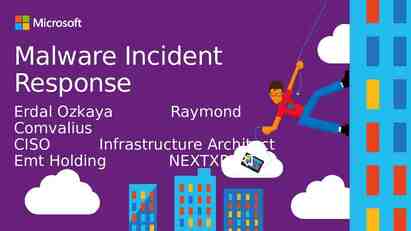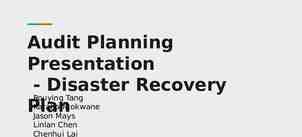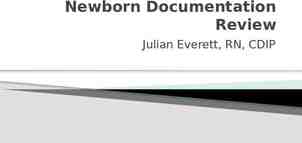Introduction to Grant Writing Mid-Valley Development Professionals
27 Slides553.50 KB

Introduction to Grant Writing Mid-Valley Development Professionals September 22, 2011 Presenters: Rick Horton & Rick Levine

Introduction to Grant Writing Agenda Welcome & Introductions Rick Horton & Rick Levine Follow the Money Rick Horton Organizational Readiness Rick Horton Project Readiness Rick Levine

Where the money is Charitable Giving in the U.S.: 2010 (in billions) Individuals: 211.8 (73%) Foundations: 41 (14%) Bequests 22.8 (8%) Corporations 15.3 (5%) Overall giving 2.1% from 2009 (source: Giving USA Foundation and its research partner, the Center on Philanthropy at Indiana University)

Before you get started Keys to Success Organizational readiness Project leadership

Readiness Checklist: Part 1 ORGANIZATION Financial Documentation Letter from IRS (determination of non-profit 501(c)(3) status) Current year budget Audited financial statement (most recently completed FY) 990-PF on file with IRS List of top donors (most recently completed FY, individuals not named) Governance and Administration Mission statement Strategic plan Business plan (operational) Board Information (details of composition and function) Organizational chart (or other explanation of how organization works) Resume(s) of organizational leaders (Executive Director, Board President) Organizational history (including major milestones) Description of audiences served (by organization) Organizational strengths, uniqueness and capacity (impact on community) Organizational credibility (program outcomes, awards, recognition) Media coverage and testimonials (from clients, partners, “authorities”) Supporting collateral materials (as appropriate)

Why Do We Need Grant Funding? It’s easy money NOT!! Money can be used wherever we need it NOT (usually)

Why Do We Need Grant Funding? To fund priority, mission-driven projects To provide budget relief (direct/indirect costs) To support innovation To address community needs To demonstrate competency & credibility The grant proposal process helps us plan!

G.R.E.A.T. Grants Are . Genuine don’t chase the Responsive address identified needs Effective have measurable outcomes Accountable financially & programmatically Timely they help if/when you’re ready

G.R.E.A.T. Grants Can provide early narrative and financial information for requests by your entire development team – Individuals – Corporations help leverage additional grants & donations – early grants attract others – challenge grants stimulate fundraising efforts – “topping off” grants can bring you to goal

Alignment of Needs Needs of Community GREAT grants! Needs of Organization Priorities of Funder

Oregon Zoo’s Alignment of Needs: Zoo Animal Presenters (ZAP) Community (Under-served Youth) Oregon Zoo Science literacy Engage diverse audiences Adult mentors Inspire Our Community Jobs Lowincome & minority youth ‘04-’09 15 fdns. 39 grants 300K foster selfsufficiency Funder Priorities

Some Issues To Consider When Thinking About Whether Your Idea is Grantable 1. Have you identified a funder that fits? Yes No (2,0) 2. Have you made contact with a potential funder? Yes No (2,1) 3. Is this a project? or operations? (2,1) 4. Is your idea exceptionally unique unusual common (3,2,1) 5. Is this a client need? or an organizational need? (2,1) 6. Is the need compelling? Extremely Strongly Moderately (3,2,1) 7. Do you know precisely what you want to do and how it will be done? Yes with a few exceptions Generally (3,2,1) 8. Do you have High Medium or Low demonstrable organizational capability? (3,2,1) 9. Is your organization Highly Moderately committed? (2,1) 10. Is your organization Highly Reasonably acceptable as a sponsor? (2,1) 11. Is the client, professional, and service community supportive? Yes No (1,0) 12. Is there a collaborative element to the project? Yes No (1,0) 13. Will this save the community any money? Yes No (1,0) TOTAL SCORE Scale: 21-27 (let’s go!); 16-20 (competitive idea); 11-15 (can this idea be strengthened?); under 11 (forget it)

Readiness Checklist: Part 2 PROGRAM/PROJECT Executive endorsement (often in the form of a proposal cover letter) Citable evidence of need or problem (with focus on needs of audience not organization) Explanation of how problem relates to organization and mission Urgency and timing of request Project design (including goals, output and outcome objectives, activities, partnerships, timeline) Resume(s)/qualifications of key project staff Project budget (line item and narrative, including plan for use of grant funds) Project evaluation plan Future funding plan (post-grant sustainability) Letters of partner commitment and/or support (current)

10 Fundamental Proposal Elements (scope & sequence determined by funder) 1. Evidence of Need or Problem identify the need/problem and explain its effects issue must relate to your mission focus on audience not organization credible citations evidence-based (data and stories) Importance/urgency 2. Project Goals and Objectives 3. Organization Credibility and Capacity 4. Project Design (who will do what to whom?, when?, why this strategy?) 5. Project Budget 6. Project Evaluation (measurement of outcomes) 7. Future Funding Plan 8. Executive Summary 9. Cover Letter 10. Attachments (as requested)

Attachments as requested (in order) IRS 501(c)(3) determination letter most recent audited financial statement current organizational budget board list/affiliations list of recent funders misc. support materials organizational chart key staff bios/resumes board member list/affiliations list of previous grants a copy of organization’s most recent strategic plan publications media coverage testimonials

What Is Grantsmanship? If you're a proposal writer, chances are you've been given a grants "wish list" and urged to "just go and get the money." Is that grantsmanship? The newly revised and soon-to-be-released version of Norton J. Kiritz's groundbreaking work, Program Planning & Proposal Writing, defines grantsmanship. In 1972, The Grantsmanship Center defined the principles of grantsmanship for an emerging profession. Since then, we have continued to champion ideals that define grantsmanship as far more than the art of writing proposals and obtaining grants. Grantsmanship is a philosophy, a code of ethics, and a set of skills applied simultaneously to bring about positive change. People who practice grantsmanship: know that the mission of their organization is service to its beneficiaries, and that grants must respond to that mission; use grants to address problems and bring benefits to the community, with the understanding that grants are not the solution to every funding need; view planning as nonnegotiable--if there is no plan, there's nothing to write about; know they don't know it all and so seek the opinions and ideas of constituents, staff, and colleague organizations; proactively search for private funders and government programs that fit their mission, rather than only reacting to random opportunities; build partnerships with funders who share their organization's goals and values, seeing them as allies, advisors, and advocates--not as automatic teller machines; are steadfastly ethical--don't misrepresent or fabricate information, disparage their peers, bend missions to qualify for funds, exaggerate problems, or promote needless programs; know what they need to know--the problem they're up against, their constituency, their community, recent research, and best practices in their field; know how to write a proposal that makes the case. A grant is just a tool. Money alone doesn't protect battered families, help children to read, fill the plates of the hungry, clean polluted lakes, or open museum doors. But when guided by a thoughtful plan from a committed organization, a grant can be a powerful catalyst for change. Organizations that practice grantsmanship are more effective. Their proposals are more likely to get funded, but more importantly, their programs are more likely to make a difference. Grantsmanship: it's not about money; it's about results. (source: {Centered}, Vol. 1, Issue 1, July 2008)

Helpful Links Nonprofit Information Nonprofit Association of Oregon: www.nonprofitoregon.org State of Oregon: www.filinginoregon.com/pages/business registry/nonprofit.html WVDO: www.wvdo-or.org Grantsmanship Resources Grant Professionals Association: http://grantprofessionals.org The Grantsmanship Center: http://www.tgci.com GuideStar: http://www2.guidestar.org Foundation Center: http://foundationcenter.org

Grant Writing Tips & Tools Mid-Valley Development Professionals September 22, 2011 Presenters: Rick Horton & Rick Levine

Tips & Tools Agenda Q & A: Proposal Components Rick & Rick Budget Do’s & Don’ts Rick Levine Prospecting for Funders Rick Horton Funding Trends Rick Levine More Resources Rick Horton General Q & A Rick & Rick

10 Fundamental Proposal Elements (scope & sequence determined by funder) 1. Evidence of Need or Problem identify the need/problem and explain its effects issue must relate to your mission focus on audience not organization credible citations evidence-based (data and stories) Importance/urgency 2. Project Goals and Objectives 3. Organization Credibility and Capacity 4. Project Design (who will do what to whom?, when?, why this strategy?) 5. Project Budget 6. Project Evaluation (measurement of outcomes) 7. Future Funding Plan 8. Executive Summary 9. Cover Letter 10. Attachments (as requested)

Budget Do’s & Don’ts DO DON’T

Prospecting for Funders “The Educated Novice” Pre-contact research & screening – Foundation Databook – GuideStar – IRS 990 tax forms – Other nonprofits – Library Foundation Center: online & cooperating collections – – – – – – – Eugene Public Library Jackson County Library Services – Medford, Multnomah County Library – Portland North Bend Public Library – N. Bend Oregon Institute of Technology Library – Klamath Falls Umpqua Community College Library – Roseburg University of Oregon - Eugene

Prospecting for Funders Pre-Contact Screening, cont’d. Geographic Programmatic Type of funding Size of funding

Relationships Relationships Relationships Identify, explore & nurture existing connections to funders (staff & board) Establish and cultivate new connections over time

Current Trends in Grant Funding Fewer capital grants More operating Smaller in size Basic services as a priority Kids & families Seniors (particularly research) Collaborations favored – New working with established – Inter-disciplinary approaches

The Top 15 Reasons Grant Proposals Get Rejected (Source: http://ahabloging.com/2008/06/the-top-15-reasons-grant-proposals-get-rejected.html) While no one can guarantee that you’ll get a grant, there are ways to guarantee that you WON’T get one. We’ve compiled a list of the most common mistakes that people make during the grant writing and submission process. If you read and avoid these pitfalls, your chance of securing a grant will raise dramatically. Mistake #15: Poor grammar, spelling errors, or factual errors. Nothing will put a Grant Officer on guard faster than a poorly written funding proposal. You must make sure that your writing style is clear, correct, and to the point. If you appear uneducated or are unable to express your goals, you are unlikely to obtain financial aid. As incredible as this sounds, many people fail to spell-check their grant requests, and some people even make mistakes in their financial figures! If you don’t take the time to make your proposal look professional, you can hardly expect a Grant Officer to take you seriously. How to fix it: Proof-read your proposal. Double-check your figures. Get a friend to read through your proposal, or even hire a professional Grant Writer. Mistake #14 Cost padding/insufficient cost research. Grant Officers aren’t stupid, and they deal with grants on a daily basis. Never guess or inflate the amount you need to accomplish your goal. For example, if you’re applying for a business grant, don’t claim you’ll need 10,000 for a piece of equipment if in fact the equipment only costs 8,000. The Grant Officer will research the actual price, and then you’ll look either incompetent or dishonest. Either way, you’ll probably be rejected. How to fix it: Research your legitimate costs, and never inflate them. Mistake #13 Failure to follow instructions precisely. As amazing as it sounds, one of the main reasons that proposals are rejected is that the applicant didn’t bother to follow the instructions for requesting the Grant! If you were going to a job interview, or trying to get your driver’s license renewed, you’d certainly follow the instructions provided. You’d realize that failure to do so would result in not getting the job or the driver’s license. Grants are the same way. If you don’t follow the instructions exactly, odds are you’ll be rejected out of hand. How to fix it: Read and follow all instructions. If in doubt, call the Grant agency and ask. Mistake #12 Failure to clearly state goals. Grant Officers don’t want to guess what you’re trying to accomplish. You MUST state your objectives clearly, succinctly, and directly. If the Grant Officer can’t grasp your goals in the first paragraph, odds are they won’t bother continuing on to the second. How to fix it: Write an outline of your goals, stated in six sentences or less. Then expand upon the outline. Mistake #11 Failure to meet submission deadlines. Of all the mistakes made by first-time Grant writers, this is the most frustrating. It doesn’t matter how good your idea, how worthy your cause, or how well you’ve written your proposal. If you fail to get your proposal in by the submission date, you may as well not have bothered. Late submissions don’t even go before Grant Officers. They go in the trash. How to fix it: Be aware of the submission deadline before you even consider applying for a Grant. Mistake #10 Grant proposal incompatible with donor. If you’re looking for a scholarship, don’t submit your proposal to the Small Business Administration. That seems like a simple enough concept. But many, many first time Grant writers simply send out their proposal scatter-shot to any agency they can find. This is a good way to rack up a lot of rejection letters, but it’s NOT a good way to get funding. How to fix it: Matching up your needs with a donor is easy. The guide you’re reading now makes it a snap to make sure you’re contacting the correct agency. Mistake #9 No business plan included. If you’re requesting a business loan, it’s not enough to simply say “I want to open a coffee shop”. Donors expect a fully realized business plan, showing that you know what you’re doing, and have a reasonable expectation of being in business six months from now. Donors exist to help you, but they do NOT exist to throw money at lost causes. How to fix it: Draw up a business plan, and include it with your proposal. Mistake #8 Failure to show benefits/results of proposal. Grant agencies do not exist to simply throw money at you. It is important that you realize that the Grant Officer who reviews your proposal will be looking at the bottom line. Who does your proposal benefit, and how? For example, if you’re seeking funding for an Adult Education program, the donor will probably want to see proof that there’s a need for such a program in your area, and what the immediate benefits will be. How to fix it: Include a prospectus outlining the end results/benefits of your proposal. p. 1/2

The Top 15 Reasons Grant Proposals Get Rejected (Source: http://ahabloging.com/2008/06/the-top-15-reasons-grant-proposals-get-rejected.html) Mistake #7 No long-term plan Donors like their donations to mean something. They like to know that the business they fund will be there next year, the non-profit entity they’re creating will continue to benefit the community, or the student they’re sponsoring will continue on to be a valuable member of the community. The successful Grant proposal shows how the Grant will benefit either the individual or society on a long-term basis. How to fix it: Include a five-year timeline, showing the goals of your project. Mistake #6 Over-reliance on grant funding. Most Grants exist to help you get started. For example, you might be able to obtain funding to build a youth center, but supporting the youth center after it’s built is up to you. Most donors will require you to show how you intend to support your project after the grant money runs out. For a small business, this means that you’ll need to prepare a profitability outline showing projected profits. For non-profit ventures, you’ll have to show where you intend to procure funding after your initial Grant. How to fix it: Prepare a long-term financial outline. Mistake #5 Grant trolling. There’s a common misconception that a person can write up fifty proposals (or one proposal, and send it to fifty agencies) and end up rolling in free Grant money. This simply isn’t true. Grant Officers can instantly recognize a generic Grant proposal, and just as instantly reject it. There’s plenty of Grant money out there, but Grant donors like to know that their money is going to valid projects. How to fix it: Make sure that you actually qualify for the Grant you’re applying for. Don’t send out generic proposals. Mistake #4 Sloppy preparation. Grant Officers are human beings just like the rest of us. If they think that you didn’t take your proposal seriously, they’ll resent the fact that you wasted their time. You simply must put forth the time and effort to present a well-prepared proposal. No matter how worthy your cause, you can ruin your entire effort simply by failing to take the time required to prepare your material in a professional manner. How to fix it: Give yourself plenty of time to assemble your materials. Many copy centers can help you with presentations, cover letters, etc. Mistake #3 Proposal lacks a “hook”. You must remember that donors see hundreds, sometimes thousands of Grant proposals a year. If you want yours to stand out, you have to show how yours is unique, original, or better than anyone else’s. If you can get the Grant Officer interested in your proposal, your chances of success shoot through the roof. How to fix it: Show how your particular proposal is different/unique. Mistake #2 Failure to recognize donor. Very few people will give you something for nothing. Grant donors like to know how they’ll be recognized. For example, if you’re building a center for the blind, your donor will probably want to know if they’ll be recognized as having donated the money. For example, they may want a plaque acknowledging their Grant, or they may even want the center named after them. Be aware that you’ll need to make concessions to their ego. How to fix it: Include a section describing how the donor will be recognized. Mistake #1 Killing the goose that laid the golden egg. There’s nothing that will kill your proposal faster than trying to push for more than your donor is willing to give. It’s better to ask and receive 1,000 than ask for 1,000,000 and be refused. You absolutely must have realistic goals before you approach the donor. How to fix it: Know a general amount that the donor generally gives. p. 2/2






